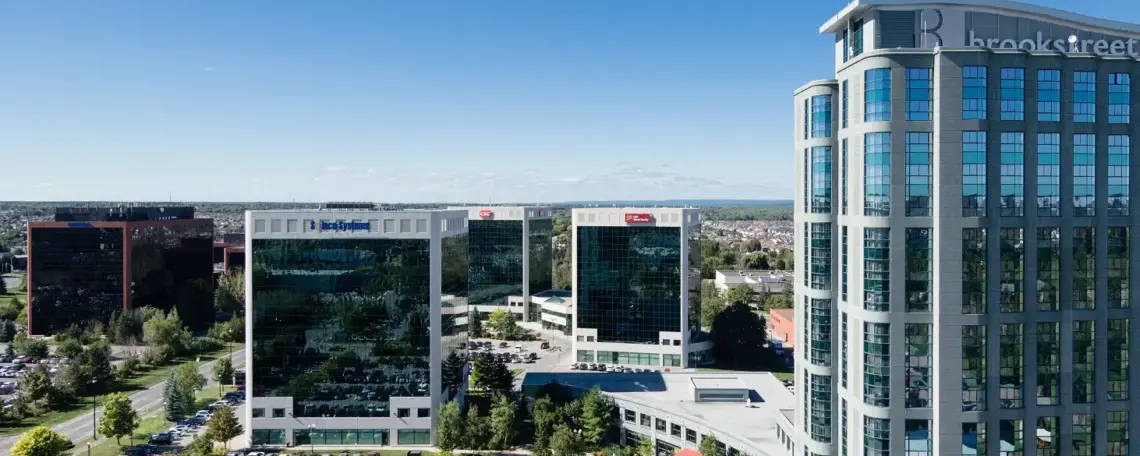
In photo above: one of the business sectors in Kanata North Technology Park
***
Kanata North a “magnet for innovators and entrepreneurs,” says report
Companies in Kanata North generate $7.8 billion in economic activity each year and employ more than 30,000 people, according to a new study.
The tech sector alone accounts for $6.6 billion of that total and provides jobs for more than 26,000 employees, or about one-third of the total number of tech workers in the Ottawa region, says the report, which was conducted by Doyletech Corporation.
“Kanata North is a magnet for innovators and entrepreneurs with a zeal for identifying opportunities and responding to needs as they arise,” said the report, which was commissioned by the Kanata North BIA and funded in part by a $7,500 research grant from the city.
Former BIA executive director Jenna Sudds noted Kanata North’s tech sector is larger than Victoria’s, which has 23,000 employees and an economic impact of $4 billion, and comparable in terms of its number of employees to Waterloo, where about 29,000 people work in the industry.
“It became quickly apparent that what we have really is a gem,” she said during a news conference.
Mayor Jim Watson said the study underlined the need to do more to promote Ottawa, and Kanata in particular, as a centre of innovation.
“I think it brings to light what a lot of us have felt, that we have a very vibrant and growing high-tech sector in Kanata, and I think we have to do a better job of selling and marketing it,” he said.
The number of tech workers in Ottawa as a whole grew from slightly more than 50,000 in 2012 to 76,000 last year, a fact that is often overlooked, Mr. Watson said.
“Everyone talks about Waterloo, but we have four or five times the number of employees and companies that Waterloo has,” he said. “Yet they’re always held up as this great role model.”
The study said Kanata North’s telecom, wireless and photonics subsector leads the way with 8,000 workers and $1.8 billion in annual revenues, followed by the software and defence and security subsectors.
The report also highlighted other subsectors with upside.
“Cleantech, in particular, is an area with robust growth potential,” it said.
While cleantech companies currently employ only 96 workers who generate $18.6 million in annual revenues, “this subsector has smaller firms and is in early-stage development,” the report says.
Firms in Kanata North generate a net GDP of $255,000 per employee, triple the Canadian average, the report concluded. Those companies contribute nearly $3 billion in annual tax revenue to all levels of government.
Sixty-four per cent of the 500 corporate members of the BIA are Canadian-owned, the study found, while three-quarters of them employ fewer than 50 people.
“That was a surprise to us,” Ms. Sudds conceded. “A lot of what we do as an organization is meeting with companies, trying to learn about their growth and their challenges. When we hear an issue from one or two (small companies), maybe we need to pay more attention because this could be a recurring theme around 75 per cent of our businesses.”
Fifty per cent of workers live within a five-kilometre radius of Kanata North, compared with the Canadian average of 36 per cent of employees who live that close to work.
But that still means about 15,000 people commute farther than that every day, Ms. Sudds noted, adding traffic on busy arteries such as March Road and Carling Avenue was a pressing issue for many of the 40 companies interviewed for the study.
“Those roadways aren’t built for the traffic that they’re seeing,” she said. “It’s only going to get worse with time, so that’s a concern for us.”
The report also identified bringing light rail to Kanata as a top priority. Stage 2 of the city’s LRT master plan calls for service to be extended west to Bayshore Shopping Centre by 2023, but no provincial or federal dollars have been earmarked for anything beyond that.
“We have to live within the reality of what money we have,” said Mr. Watson. “This (study) will act as a great catalyst for further discussions. If we can get the federal and provincial governments to fast-forward more dollars, then we can move LRT west faster. If we can get their support to go farther west, then I’m all for it, but we have to be cautious of the fact that we don’t want to mislead people.”
Employers also pointed to a shortage of skilled workers and a lack of restaurants and conference facilities in the area as other key concerns.
